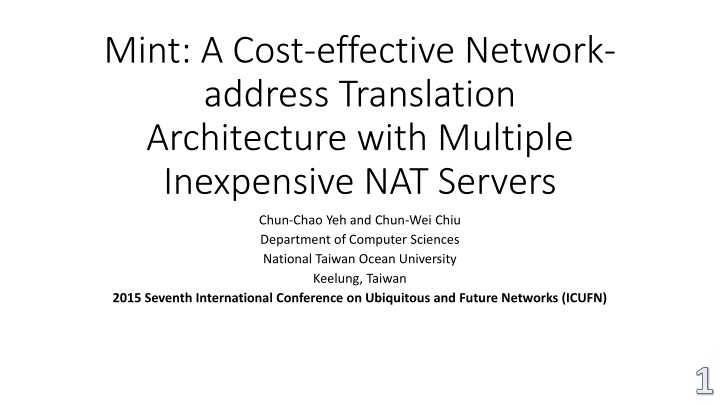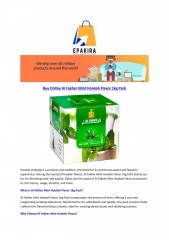Mint: Cost-Effective Network-Address Translation Architecture
Mint (Multiple Inexpensive Network-address Translation) presents a cost-effective, scalable, fault-tolerant, and flexible approach to handling IP address depletion by utilizing multiple NAT servers. The system architecture includes NAT servers and a Mint-NAT gateway to enhance packet handling efficiency. Experiment results demonstrate the effectiveness of the proposed architecture in managing network address translation.
Download Presentation

Please find below an Image/Link to download the presentation.
The content on the website is provided AS IS for your information and personal use only. It may not be sold, licensed, or shared on other websites without obtaining consent from the author.If you encounter any issues during the download, it is possible that the publisher has removed the file from their server.
You are allowed to download the files provided on this website for personal or commercial use, subject to the condition that they are used lawfully. All files are the property of their respective owners.
The content on the website is provided AS IS for your information and personal use only. It may not be sold, licensed, or shared on other websites without obtaining consent from the author.
E N D
Presentation Transcript
Mint: A Cost-effective Network- address Translation Architecture with Multiple Inexpensive NAT Servers Chun-Chao Yeh and Chun-Wei Chiu Department of Computer Sciences National Taiwan Ocean University Keelung, Taiwan 2015 Seventh International Conference on Ubiquitous and Future Networks (ICUFN) 1
Outline Introduction What is NAT? What is MAC-rewrite? What is Multiple NAT? System design A. System Architecture and Assumptions B. Packet Handling Experiment results Concluding remarks 2
Introduction Mint (Multiple Inexpensive Network-address Translation) All devices require IP addresses in IoT, it is believed that IPv4 (IP address version 4) addresses are going to be exhausted in the near future, wide deployment of IPv6 is unsure. Cost-effective: provide similar packet-processing power with less cost. Scalable: allow NAT servers to be added/removed on-demand. Fault-tolerant: prevent single-point of failure via multiple NAT servers. Flexible: for example, the approach can effectively support multi- homing connections (multiple connections provided by different ISPs). 3
NAT: NAT mechanisms enable a group of hosts to share one (external) IP address, while each of the hosts inside the NAT owns their (internal) IP addresses. 5
System design A.System Architecture and Assumptions There are two major components in the proposed parallel NAT architecture (Mint-NAT): NAT servers and Mint-NAT gateway. NAT servers:Address translation for each incoming/outgoing packets. Mint-NAT gateway: As a proxy for all the NAT servers included. Can select a proper NAT server and forward the client packet to the server for NAT services. 8
Experiment results A. System Prototype Implementation and Experiment Setup three Asus RT-N10+ and one TotoLink N300RT 11
two networks were created, one for the (internal) NAT network (network address 10.0.1.0/24), the other for external network (network address 10.0.2.0/24).Both of the switches are gigabit Ethernet switches (SMC GS801 for SW-l and Asus GX-D1051 for SW-2). We setup a simple http page with plain text of 644 bytes, which can be transmitted in single Ethernet frame and thus eliminate possible packet partition overhead. 12
B. Experiment Results (with one, two, and three NAT devices (Asus RTN10+) respectively) are 90, 180, and 270 connections per second. The case for four NAT devices (4-nat) resulted in a rate of 320 connections per second. 15
Concluding remarks In this paper, we present a cost-effective NAT service architecture based on multiple NAT servers. The proposed system architecture, named Mint, utilizes MAC-rewrite techniques and integrates a set of (inexpensive) NAT servers to share the NAT operation loads for each network packets passing between the NAT networks. We demonstrated the design concept with a prototype system, which includes four NAT devices and a NAT gateway. Experiments on the prototype system show that the sustained http connection rate can grow linearly whenever more NAT devices being added to the system. 17























